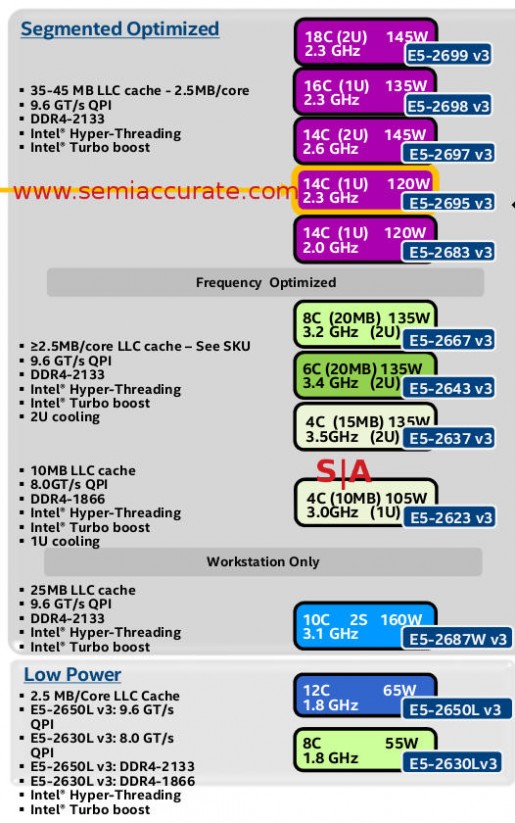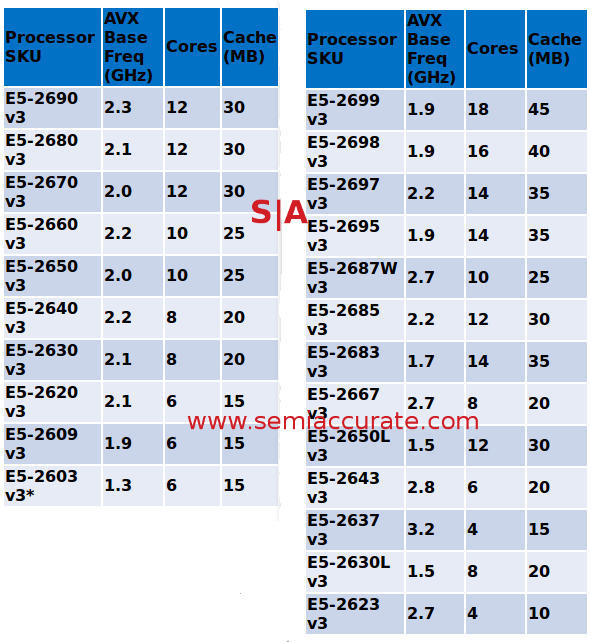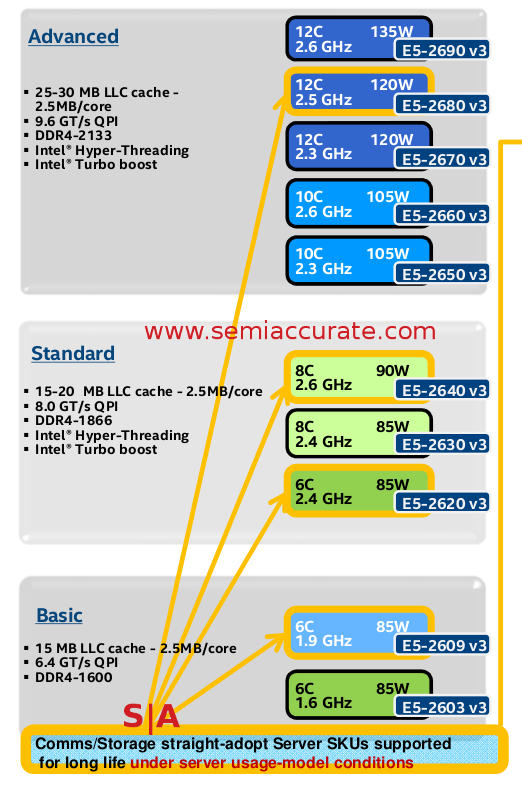 Intel now has more than 20 new CPUs from three die for its new Grantley platform, lets see what they are. This article only covers a bit of the basics, mainly speeds and feeds, the tech will be covered elsewhere.
Intel now has more than 20 new CPUs from three die for its new Grantley platform, lets see what they are. This article only covers a bit of the basics, mainly speeds and feeds, the tech will be covered elsewhere.
There are 22 official SKUs released, plus many many more that are vendor-specific, task specific, not yet released, and much more. Since these aren’t official yet, we won’t talk about them here, but that still leaves us with enough for several articles. Think of this piece as an overview of the lines that will line up the various sections in a close to sane way. We will mention a lot of tech and terms but won’t try to explain it here, all that will be in the series of articles starting here.

Three dies, baby, mama, and papa Haswell’s
Haswell-EP has three dies called LCC, MCC, and HCC, basically small, medium and large that don’t really line up to any product category. As you can see above, the smallest LCC die has eight physical cores and can be fused down to four. MCC can have between 6-12 cores so a six or eight core part could go either way. TDPs and nearly everything else overlaps a bit too.
The Grantley platform supports DDR4 at speeds up to 2133MHz but some SKUs cap that lower. QPI links also come in three speeds, 6.4, 8.0, and 9.6GT/s, again depending on SKUs, most likely to lower power use on things that don’t need more bandwidth. Given the wide ranges of cores, clocks and features, expect the communications between CPUs to vary widely too. This is the long way of saying both DRAM and QPI speed could have a technical basis for their choices.
The basic three segment Haswell-EP stack
The first thing to note is that the blue background SKUs are based on the MCC die, green are based on the LCC die. The purple boxes below are HCC as well, the only one out of place is the 6C E5-2609v3 for technical reasons, likely the second Home Agent for comms use. The rest are pretty cleanly separated as you might expect. The yellow boxed SKUs are comms or storage parts meaning they have a longer availability, can have an elevated T-Case, and several other features beyond the scope of this article. Comms SKUs can be outfitted with the 89xx or the normal C610 chipset.
There are three main classes of mainstream CPUs, Advanced, Standard, and Basic which are similar to previous E5 lines. Basic has QPI capped at 6.4GT/s and DDR4 at 1600MHz, HT and Turbo are fused off. Standard adds DDR4/1866 support, 8.0GT/s QPI, HT, and Turbo. Advanced ups QPI to 9.6GT/s and DDR4 2133 support, but in general there are no surprises. TDPs broadly adhere to what you would expect given core and frequencies as well.

Segmeted by lines or something like that
Segment optimized dies are where things get interesting although we aren’t really sure what exact segment needs the HCC die. That said it is basically the Advanced segment from the earlier group with many more cores, how can you complain? Frequencies may be a little lower than the top Advanced parts, but throughput goes up significantly.
If frequency is a big concern you can take a look at the next group, Frequency Optimized SKUs. These are all what you might expect, basically two core versions of the Haswell-E’s just launched a few weeks ago. The top E5-2667v3 is a pretty plain part, an Advanced class CPU built from the LCC die but the middle two are quite interesting. E5-2643v3 an E5-2637v3 have six and four cores respectively but keep the same 135W TDPs trading core count for clock but that is pretty standard.
Where you might find them a bit more interesting is that they don’t disable all the L3 cache slices. Up till this point all of the SKUs had the standard 2.5MB L3 slice per core, these two parts change that. They effectively leave the cache for two of the disabled cores on adding 5MB to the total available for the remaining cores. Earlier Intel CPUs couldn’t do this at all, L3 caches were fused off along with the cores. The possibility of leaving it on could make for some very interesting SKUs if used with the HCC die.
The lowest ranking member of the Frequency Optimized clan goes back to 2.5MB L3 per core and also looses QPI and DDR4 speeds. It is essentially a Standard class part with less cores and running at higher clocks. If you are thinking that it would be a good gaming part, the two big cache variants are a better choice for the gamer with too much cash to blow on cache. Also note that Frequency Optimized SKUs come bundled with thermal solutions aka heat sinks.
Oddly the Workstation SKUs, or in this case Workstation SKU, doesn’t come with a heat sink, not sure why that is. That said Workstation seems to mean higher clocked and higher TDP MCC die Advanced class SKU. Low Power class parts are just the opposite of Frequency Optimized and Workstation, a fully enabled MCC and LCC die with QPI and DDR4 speeds set as high as needed. In short they trade TDP for frequency too but aim for the other side of the curve.

AVX Turbo frequencies in one place
AVX Turbo is another interesting feature and it is unquestionably a good thing even if it doesn’t look that way at first. Read the explanation here if you don’t get why. The AVX base frequency is almost always 3-400MHz lower than the normal base frequency with a few minor exceptions. We are mainly including this because we couldn’t find it anywhere else and thought people would want to know the specifics. If you want to know the details as to how and why it works, once again take a look at the technical articles.
In the end there are 22 new Haswell-EP aka Intel Xeon Processor E5-2600 v3 processors you can now buy for your upcoming Grantley build. They are better than their Romley predecessors in almost every way but you probably don’t get that from the SKUs and overview. In this case the advances are in the details, and there are a lot of them to talk about. Better yet there are going to be a lot more coming over the next 18 months or so until Broadwell server parts arrive, stay tuned.S|A
Charlie Demerjian
Latest posts by Charlie Demerjian (see all)
- Intel Announces their NXE: 5000 High NA EUV Tool - Apr 18, 2024
- AMD outs MI300 plans… sort of - Apr 11, 2024
- Qualcomm is planning a lot of Nuvia/X-Elite announcements - Mar 25, 2024
- Why is there an Altera FPGA on QTS Birch Stream boards? - Mar 12, 2024
- Doogee (Almost) makes the phone we always wanted - Mar 11, 2024
